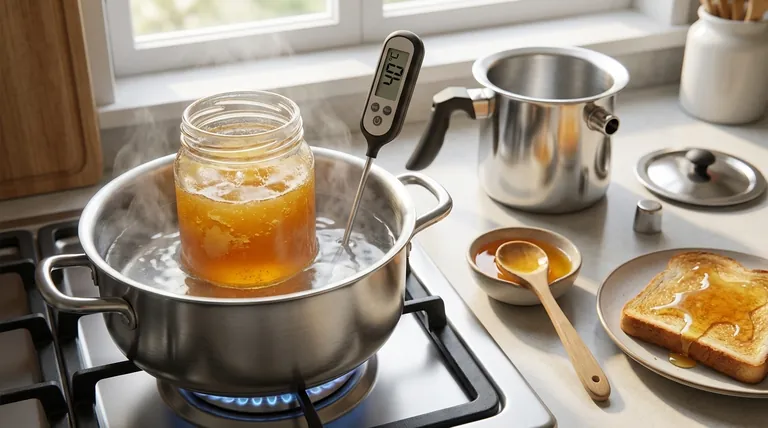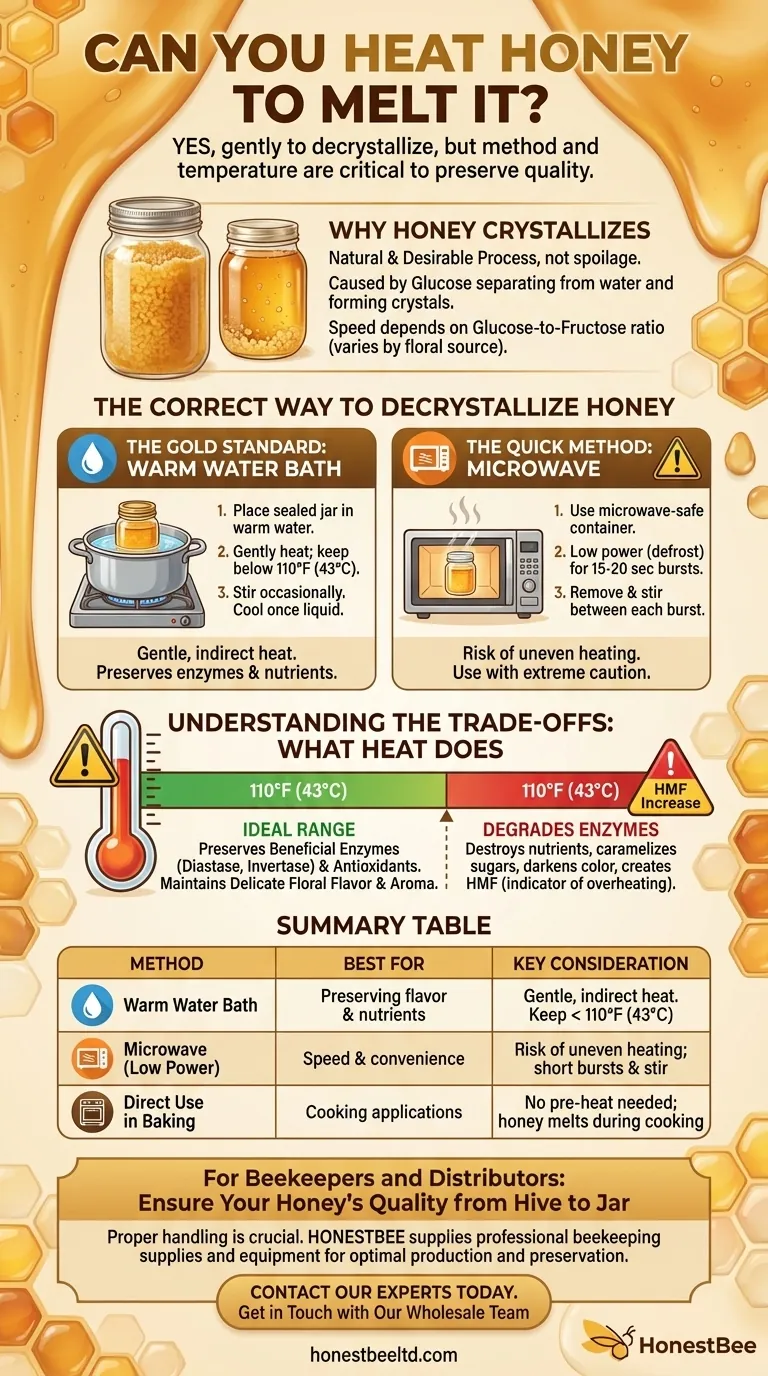Yes, you can and should heat honey to reverse crystallization and return it to a smooth, liquid state. This process, known as decrystallizing, is common and safe. However, the method and temperature you use are critical, as excessive heat can negatively impact the honey's delicate flavors and beneficial properties.
The core principle is simple: gently warming crystallized honey will melt its sugar crystals and restore its liquid texture. The challenge lies in applying just enough heat to achieve this without overheating the honey, which can diminish its unique enzymes, aromas, and nutritional qualities.

Why Honey Crystallizes
Before discussing how to fix it, it’s important to understand that crystallization is a natural and often desirable process. It is a sign of high-quality, raw honey, not spoilage.
A Natural Process, Not a Flaw
Honey is a supersaturated solution of sugars, primarily glucose and fructose, in a small amount of water. Over time, the glucose tends to separate from the water and form tiny crystals, which spreads until the entire jar becomes thick and grainy.
The Role of Glucose and Fructose
The speed of crystallization depends on the honey's specific glucose-to-fructose ratio, which varies by the floral source. Honey with a higher glucose content, like clover or dandelion honey, will crystallize quickly. Honey with a higher fructose content, such as acacia or tupelo honey, can remain liquid for years.
The Correct Way to Decrystallize Honey
The goal is to use gentle, indirect heat. This melts the crystals slowly and evenly without creating "hot spots" that could scorch the honey and damage its quality.
The Gold Standard: A Warm Water Bath
This is the most reliable and gentle method. It gives you maximum control and preserves the honey's integrity.
- Place your sealed jar of honey in an empty pot or bowl.
- Fill the pot with warm water, ensuring the water level is below the lid of the jar.
- Gently heat the water on the stove over low heat, or simply let the jar sit in very hot (not boiling) tap water. Do not let the water boil.
- Stir the honey occasionally as it warms to speed up the process. Once it is fully liquid, remove it from the water and let it cool.
The Quick Method: The Microwave
While convenient, using a microwave is riskier because it heats unevenly. If you must use this method, do so with extreme caution.
- Ensure your honey is in a microwave-safe container (remove any metal lids or foil).
- Microwave on a low power setting (like the defrost setting) for only 15-20 seconds at a time.
- Remove and stir the honey thoroughly after each interval. Repeat until the crystals are dissolved. Never let it boil.
Understanding the Trade-offs: What Heat Really Does
The claim that heat makes "no significant change" is an oversimplification. While it won't make honey unsafe, high heat does alter its composition in meaningful ways.
The Impact on Enzymes and Nutrients
Raw honey contains beneficial enzymes, like diastase and invertase, and antioxidants. These compounds are sensitive to heat. Temperatures above 110°F (43°C) begin to degrade these enzymes, and higher temperatures will destroy them entirely.
The Effect on Flavor and Aroma
Overheating can also caramelize the sugars in honey. This fundamentally changes its flavor profile, masking the delicate floral notes and replacing them with a generic, slightly burnt sugar taste. The honey will also darken in color.
The Creation of HMF
Heating honey, especially at high temperatures, increases its levels of a compound called Hydroxymethylfurfural (HMF). While not harmful in the amounts found in food, HMF is widely used in the honey industry as an indicator of overheating or old age. Low HMF levels are a marker of high-quality, carefully handled honey.
Making the Right Choice for Your Goal
The best method for you depends on what you value most.
- If your primary focus is preserving maximum nutritional benefits and flavor: Use the gentle warm water bath and keep the temperature low and controlled, never exceeding 110°F (43°C).
- If your primary focus is speed and convenience: Use the microwave on its lowest power setting in very short bursts, accepting the risk of some minor quality degradation.
- If you are using the honey for baking or cooking: Don't worry about pre-heating to decrystallize it. The honey will be heated during the cooking process anyway, so just scoop it out as needed.
By understanding how to apply heat correctly, you can easily restore your honey's liquid texture while protecting the unique qualities that make it valuable.
Summary Table:
| Method | Best For | Key Consideration |
|---|---|---|
| Warm Water Bath | Preserving flavor & nutrients | Gentle, indirect heat; keep temp below 110°F (43°C) |
| Microwave (Low Power) | Speed & convenience | Risk of uneven heating; use short bursts and stir frequently |
| Direct Use in Baking | Cooking applications | No need to pre-heat; honey will melt during the baking process |
For Beekeepers and Distributors: Ensure Your Honey's Quality from Hive to Jar
Proper honey handling is crucial for maintaining the premium quality your customers expect. At HONESTBEE, we supply the professional beekeeping supplies and equipment that commercial apiaries and distributors rely on for optimal honey production and preservation.
We can help you source the right tools to manage your product effectively. Contact our experts today to discuss your wholesale needs and how we can support your operation's success.
Get in Touch with Our Wholesale Team
Visual Guide

Related Products
- Beeswax Melter for Candle Making Honey Bee Wax Melter
- 10L Stainless Steel Electric Honey Press Machine
- Steam Beeswax Melter Wax Warmer for Wax Processing
- HONESTBEE 72 Frame Industrial Electric Honey Extractor for Beekeeping
- High Quality Honey Dehumidifier Dryer Thickening Machine for Beekeeping
People Also Ask
- What is the flashpoint of beeswax? Essential Safety and Quality Tips for Beekeepers
- What do you use a wax melter for? From Home Fragrance to Professional Beekeeping
- What are the primary products of honey bee farming besides honey? Discover the Hive's Hidden Treasures
- What makes polyurethane foam environmentally friendly? The Surprising Benefits of a Durable, Inert Material
- How does a steam wax melter work? A Fast, Efficient Method for High-Quality Wax



















